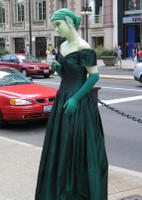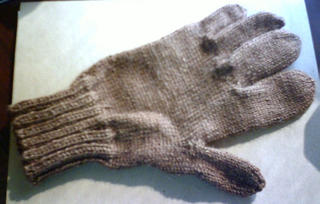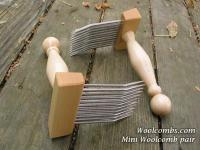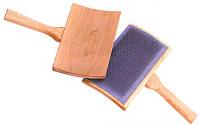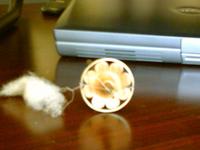
Knitting with this yarn was a real pleasure – it flows through the fingers like silk, but with all the softness of fine alpaca and wool. The finished fabric is beautiful, with good stitch definition and just enough bloom to make the gloves lovely and warm.
But back to the beginning of this project! It had been about a year since I did my last pair of gloves, so I started looking for a pattern on the web, and found nothing for an extra-large men’s glove for worsted-weight yarn. So I pulled out my old magazines and found the glove issue (Winter 2003) of Knitters from Interweave Press. Yes! Exactly what I wanted – guidelines for making gloves that would fit him exactly!
You know, as a beginning knitter, socks didn’t scare me. I completed my first three pairs before I realized that turning a heel was supposed to be difficult. Gloves frightened me, though. How on earth could you pick up all those stitches for fingers and knit them to just the right length? What if you picked up too many or too few stitches – could you take them back out? It just looked too complicated!
Well, time went on. I knitted hats, mittens, baby sweaters, and i-cord. Small tubes didn’t make me nervous anymore. Then I saw that issue of Knitters and a light-bulb went off in my head. I could do this! And I did, making gloves for myself during Winter 2003 and more pairs for Christmas 2004 gifts. I’ve even gotten bold, making color-patterned gloves and learning all about how gauges shift when yarn is carried. But for some reason these simple gloves for my DH made me nervous. Perhaps because I really wanted them to fit him perfectly – after all, he’s my chief fiber enabler. So I’ll offer these guidelines for others who want to make gloves that fit exactly!
1. Swatch! And wash your swatch! Measure it both before and after washing! I know this is elementary, but it’s an absolute if any wearable is going to fit properly. This particular yarn was designed to be used for sweaters and hats and such. The recommended gauge on the yarn sleeve is 4.5 – 5 stitches per inch on size 7 or 8 US needles. Unfortunately, this doesn’t suit at all for gloves. The fabric is too loose, and allows too much wind and cold through. If you felt the gloves enough to keep the wind out, they’re too stiff for comfort. So you have to swatch in order to find a fabric that will keep the cold out, but still move easily with the myriad hand movements we make, even outdoors in winter cold. I started out with size 5 needles, but that fabric (at 5.25 stitches per inch) was still too loose. I moved down to size 4 needles, and that was better (5.5 stitches per inch), but still not quite what I wanted. So I finally went to size 3 (3.25mm) Brittany wooden double-point needles. That was exactly what I needed – a fabric of 6 stitches and 8 rows per inch which was nice and dense, but still with plenty of give. And knit at this gauge there was a slight bloom upon washing, but no real shrinkage or felting.
I always work on 5 double-point needles. I find that a less acute angle between needles, and thus stitches, makes for less laddering problems. But if you prefer 4 double point needles, or even one or two circular needles, go for it. A word to those who like doing small circumferences on a large circular, though – I’ve never been able to get it to work well on the fingers. The circumferences are just too small.
2. Take accurate measurements! A surprise isn’t really a pleasure for either the recipient or the maker if it has to be re-done before it can be worn. If you can manage to take your measurements surreptitiously, great. But if the only way to get good measurements is to sit down with the intended wearer and a tape measure, by all means do it. My DH got a great deal of pleasure from watching me work on his gloves, bragging to everyone that these were for him, made exactly to measure!
The easiest thing to do if you won't have ready access to the person for whom you're knitting is to simply trace around their hand on a piece of paper. Measure the hand width and double that number (front and back of hand) at each of the points listed in the paragraph below. Add an inch's worth of stitches at your gauge (6 stitches per inch in this case) to allow for the thickness of the hand. And you have it. You might want to check to be sure their hand isn't unusually thick - if so you can add a few extra stitches to make up for it. (Thanks to Fran for this editorial note.)
The minimum measurements for gloves are: wrist circumference, knuckles circumference, gusset circumference (around hand at base of thumb, at the widest point of a fist), hand length from base of wrist to tip of longest finger, and ribbing length desired. Write these down – believe me, you won’t remember a week later and these sizes need to be exact!
3. Ask or look to see how the wearer wants the gloves to fit. Gloves are like socks – some people like a little room, others like them to fit tightly. I make gloves for myself with a slightly negative ease, but my DH prefers a bit of room.
4. Do the math! Your gauge swatch will give you not only stitches but rows per inch. You’ll need that later, so write it down. Your written instructions don’t need to be elaborate, but they do need to be legible – you have that second glove to make, after all! Figure out exactly how many stitches you need to cast on for the wrist and then decide on the ribbing you’ll use. I was lucky – DH’s wrist circumference was just a hair over 8.5 inches, giving a cast on (at 6 stitches per inch) of 51 stitches. So I cast on 52 stitches for a couple of reasons. First, I wanted a long ribbing of 3 inches so that the gloves would slide well under his coat sleeve band, and his wrist expands into a larger arm measurement within those 3 inches. Second, he likes his gloves to fit loosely. A 52-stitch cast-on would take care of both of those, and also be divisible by 4, which would allow my preferred K2P2 ribbing.
5. Check the difference between the knuckle and wrist circumference. Some people have less than an inch difference between these measurements, but some people have considerably more. If the difference is less than an inch, I don’t bother with increases. But if it’s an inch or more, I plan increases in the first row after the ribbing. My DH’s is exactly an inch, so I planned for 5 increases in the first row after the ribbing. This makes the glove hand exactly the diameter of his hand (9.5 inches at 6 stitches per inch equals 57). By the time allowance is made for the width of the fabric itself, this gives a fit exactly the way he likes it – slightly loose. I would subtract ¼ - ½ inch from the actual measurement to get the tight fit I prefer for myself, and with only ¾ inch difference between the two measurements normally don’t do any increases unless I’ve chosen a rather inelastic fiber like cotton.
6. Start your gusset increases about an inch from the point where the ribbing ended (on the 9th row for my DH’s gloves). This is the first place your row gauge will come in handy. I like an asymmetric thumb gusset, so that’s what I’ll use in these instructions. If you prefer another gusset style, by all means use it. I divide my stitches into fourths fairly automatically, making adjustments as needed so that the center of the round falls between the end of the second and beginning of the third needle. This makes starting a gusset easy – for the left hand the drill is knit to 2 stitches from the end of the second needle, place a marker, increase 1 stitch, knit 4, place another marker, and continue. On the next round, knit even. Continue, alternating an increase round with a plain one, until you have enough gusset stitches.
What’s enough? How much difference is there between your knuckle measurement and your gusset circumference measurement? In the case of my DH, there’s 1.75 inches. So I increased every other round until I had 12 stitches between the markers. 12 stitches is 2 inches at your 6 stitch per inch gauge. 12 minus the 8 stitches you increased is 4 stitches, or 3/4 inch. Yes, this will make the gusset have a slight negative ease – ¼ inch – but you’ll make up for that when you pick up the palm stitches to knit your thumb. I’ll grant that I just did this and hoped it would work out, since the gusset, at 12 stitches, was exactly the right length (judged by trying it on my DH). But then I looked back at various patterns and found that it was fairly common to have a slight negative ease at this point.
On the next round I transferred the gusset stitches to a double strand of worsted-weight yarn, threading it though a yarn needle and slipping the stitches purl wise onto the yarn. I then did a backward-e cast on of the original 4 stitches (those between the markers, remember?), taking me back to my original 57 hand stitches. On the next round I put two of those cast-on stitches on the 3rd needle, and left two on the second needle. Do cast these stitches on snugly, but don’t obsess too much about slightly loose stitches here – you can tighten them up when you knit the thumb.
7. Now it’s time to look at your row gauge again. How much room do you need from the end of the gusset, which should fall at the bend of the thumb, to the point where you’ll start the fingers? It’s different for everyone, but the average is between 1 and 2 inches. If the recipient is handy, they can try it on; but if not, you’ll have to make a choice. My own smaller hand only needs an inch plus one row; my DH needed almost 2 inches (18 rows). Knit those rounds even, and stop on the final round at the end of the second needle – just above the mid-point of the thumb gusset, with two of the stitches you cast back on at the front of the hand, and the other two at the back.
You’re about to figure your fingers, so put down the knitting and grab a pencil and the calculator. Do all your figuring first – then knit! And don’t worry if the amounts of stitches seem a little scanty – you’re going to be adding stitches between the fingers.
Your first finger will be done on 1/3 of the total number of stitches. In the gloves I made for my DH, 57 divided by 3 is 19. The middle finger will be done on ¼ of the total number of stitches – in this case that will be 15 stitches. The ring finger and little finger will divide the remaining stitches. 57 minus 19 minus 15 equals 23. That won’t divide evenly in half, so I used 12 stitches for the ring finger and 11 for the little finger.
Next decision: How much room do you need between fingers? The usual rule of thumb is ¼ to ½ inch’s worth of stitches, but not more than 4. On gloves for myself at a gauge of 6 stitches per inch, I’d cast on 2 stitches for the fourchette (between fingers) stitches, but my DH is quite a bit larger than I am. I’ll use three stitches for him.
8. Now you’re ready to knit the fingers. First transfer ALL the hand stitches (yes, all of them) to a doubled strand of yarn of a different color than that you’re working with. It makes seeing what you’re doing much easier. Now use one double point to pick up 9 stitches from the palm (orient yourself by the thumb opening) and 10 from the back-of-hand stitches. There’s your 19 stitches. Your thread will already be at the midpoint if you divided your stitches as I suggested above. Knit around to the space between the first and middle fingers; add 3 fourchette stitches using the backward-e cast-on technique onto a third needle. Continue knitting around. After another row or two, redistribute your stitches on the needles so that you have some support for that fourchette. I tend to work these small tubes on either four or five double-point needles, whichever is more comfortable at that time. Keep knitting the tube around and around until the length is even with the end of the finger. Next row, knit 2 stitches together around, reducing the number of stitches by half, and then do another knit 2 together round. You’ll end up with no more than 5-6 stitches. Cut a long yarn tail, run it through the stitches twice, then draw together tightly. Take the end to the wrong side and weave it in.
9. For the middle finger, you’ll use 8 stitches from the palm side and 7 from the back-of-hand side, just to keep things even. Pick these up on two double point needles. Take a third needle and pick up the 3 fourchette stitches from the first finger. If necessary, pick up an extra stitch at each corner and decrease it away by knitting two together on the next round – that will help eliminate any holes. Attach your thread at the ring-finger end of the back-of-palm stitches and knit that needle, then the fourchette pick-ups and the palm stitches. Now do a backward-e cast-on of three more fourchette stitches to take care of the space between the middle and ring fingers. Knit a round, decreasing any extra stitches, then redistribute the stitches more comfortably. Again, continue knitting until just at the end of the finger, and fasten off in the same manner as for the first finger.
You’ll have an extra end where you started this finger. Use that to help eliminate any holes, too. Instead of just weaving it in for a half-inch and cutting it off, take it around in duplicate stitch and use it to double the thickness of the yarns around those holes. That should take care of any holes easily.
10. Do the ring finger much the same as the middle one; pick up 6 stitches each from the palm and back-of-hand, the 3 fourchette stitches between this and the middle finger, and add 2 or 3 stitches between the ring and little fingers. By this time it’s probably quite comfortable, and you’re anticipating what you should do. Again, pick up an extra stitch in the corners if needed, and decrease them away on the first round. Knit round and round to the desired length, and do the decreases and finishing as for the first and middle fingers.
11. You’re down to the little finger. Pick up the remaining 11 stitches on two needles, pick up the fourchette stitches from the ring finger, and knit around to the end of the finger. Decrease as for the other fingers, and weave in all ends.
12. Now for the final effort. Go back to the thumb. Of course you can do this at any point after the gusset stitches are completed, but I usually do it last of all. To many knitters, the thumb can be tricky. You’ll first slide the live stitches on your yarn (12 of them, remember?) back onto two or three double point needles. Now pick up at least the 4 stitches you cast onto the palm on another double point needle. I normally pick up two extra stitches, one at each end, to help eliminate holes and provide a bit of extra ease. So I picked up a total of 18 stitches. Attach your yarn, beginning to knit at the palm side of the stitches. Continue to knit around, just as for the fingers, until you’re at the end of the thumb. Knit 2 together around, then knit 2 together around again. You’ll have 4 or 5 stitches to finish off just as you did the fingers.
13. If you haven’t already, weave in all your ends, including the cast-on back at the ribbing. Make the right glove just as you did the first one, EXCEPT: when you start the thumb gusset, change your point of increase. On that 9th round, knit to 2 stitches from the end of the second needle, place your marker, knit 4 stitches, increase 1 stitch, then place the second marker. Just shift your increases to the other end of the markers! Proceed just as you did for the left glove, doing a plain round between the increase rounds until you have the required number of gusset stitches. That will make left and right handed gloves, with all the increases on the palm side. Continue exactly as for the left glove.
Now wash the gloves, finger-block carefully, and let dry. Then box nicely, and don’t forget to include both fiber content AND washing instructions!
These make beautiful small gifts for Christmas or birthdays, and the amounts of yarn needed are so small that you can afford to use those beautiful cashmere yarns you lust after at your LYS. 100 grams will do anything up to an adult large glove. (However, I used about 120 grams for my DH’s extra-large gloves.) They work up amazingly fast, with a pair of simple gloves taking no more than a week of evening knitting. They’re astounding to the recipient, who doesn’t have a clue how simple they are to make. And like socks they’re easy to ‘dress up’ with fancy stitches or color work bands. How about duplicate-stitching initials into the palm stitches just above the ribbing band? Or even eliminating ribbing entirely and doing color work rounds in place of the ribbing? You can use them as the swatch for a Fair Isle sweater and have a matching pair of gloves for your cardigan!
Like socks, the techniques for gloves are easily memorized, and they’re great carry-along knitting, as well as being great summer knitting. Working on them in public is a sure-fire conversation starter, too, since so many people can’t believe what their eyes are showing them (especially if you’re working on the last couple of fingers). “Are you really making gloves?” is the usual comment, delivered in an amazed tone. My usual reply is a rather smug “Absolutely.” The conversation always continues from that point, and I’ve ‘hooked’ several fiber addicts through knitting gloves in public.
So gather some beautiful wool or wool-blend yarn to match your favorite winter coat and a tape measure. I’ve synthesized and meshed several things together from not only the three articles in that Winter 2003 copy of Knitters, but my own experiences for the steps outlined. Follow the steps above, or pull out your own copy and follow the steps in the articles given. Make your first pair. But beware – gloves are almost as addictive as socks! Don’t say I didn’t warn you!

